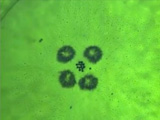|
|
TODAY.AZ / Weird / Interesting
Self-assembling microparticle machines pick up and transport material, forming spontaneous assembly lines - VIDEO
10 August 2011 [10:30] - TODAY.AZ
 Small colonies of swimming magnetic particles can self-assemble into micro-machines that can manipulate other particles, scientists report.
Small colonies of swimming magnetic particles can self-assemble into micro-machines that can manipulate other particles, scientists report.The particles can be remotely controlled to grasp and move other objects, which could enable precise and delicate fabrication processes that were previously not possible with machines.
The ferromagnetic particles are sandwiched between layers of water and oil, and they float around aimlessly in the absence of a magnetic field, according to researchers at Argonne National Laboratory. But when an alternating field is applied perpendicular to the liquid, the particles glom together into spiked circular shapes, which the researchers nicknamed asters (after the flower with similar appearance). The star-shaped formations deconstruct when the current is switched off.
Another magnetic field parallel to the surface manipulates the vortices around the asters, which makes the particles swim. Changing this magnetic field alters their movement, according to Alexey Snezhko and Igor Aronson, physicists at ANL. This allows them to be precisely controlled so they can complete certain tasks, Snezhko said — they’ve dubbed the asters “micro-robots.”
The asters can swim around, open wide like Pac-Man and hug another object, transporting it to another spot. Watch the video below, wherein one aster curls up and transports a small glass bead across the field of view, with gracefully organic movement. The glass bead weighed four times that of the self-assembled aster, according to an ANL news release.
Most robots have a hard time gripping delicate objects; the balance between sensitivity and a forceful grasp is a major challenge for roboticists. So the ability to grasp tiny fragile objects could make the asters useful for microscale manufacturing.
The same team previously developed self-organizing filament chains that served as magnetic snakes, which involved magnetic microparticles floating on water. But those were too big, because the density difference between the water and the air above was too great, as Wired Science points out. In this case, the use of two liquids — oil and water — allowed Snezhko and Aronson to create smaller structures.
So far, the researchers can manipulate the asters to carry particles as small as 150 microns and as large as 3 millimeters, within sub-millimeter accuracy, Wired reports. They could someday be used for a wide range of processes, from fabrication to medicine. The research is published in Nature Materials.
/Popular Science/
URL: http://www.today.az/news/interesting/92217.html
 Print version
Print version
Views: 1789
Connect with us. Get latest news and updates.
See Also
- 06 December 2024 [22:20]
Are scented candles harmful to health? - 23 November 2024 [14:11]
Magnitude 4.5 earthquake hits Azerbaijan's Lachin - 20 November 2024 [23:30]
Launch vehicle with prototype of Starship made its sixth test flight - 27 October 2024 [09:00]
Fuel prices expected to rise in Sweden - 24 October 2024 [19:14]
Turkiye strikes terror targets in Iraq and Syria - 23 October 2024 [23:46]
Kazakhstan supplied almost entire volume of oil planned for 2024 to Germany in 9 months - 23 October 2024 [22:17]
Taiwan reported passage of Chinese Navy aircraft carrier near island - 23 October 2024 [21:50]
Russia remains largest oil supplier to India - 16 October 2024 [17:54]
Gamesummit co-founder shares insights on future of gaming industry in Azerbaijan [EXCLUSIVE] - 12 October 2024 [18:27]
TikTok cuts jobs, turns to AI for content moderation
Most Popular
 UNESCO celebrates 950th anniversary of Diwan Lughat al-Turk
UNESCO celebrates 950th anniversary of Diwan Lughat al-Turk
 More Armenians fly: the crisis of power in Canada
More Armenians fly: the crisis of power in Canada
 Azerbaijani delegation participates in internet governance forum in Riyadh
Azerbaijani delegation participates in internet governance forum in Riyadh
 Rubik Vardanyan surprises his own lawyers
Rubik Vardanyan surprises his own lawyers
 Armenian militant group threatens regional stability aligning with PKK/YPG in new ground
Armenian militant group threatens regional stability aligning with PKK/YPG in new ground
 Azerbaijan's role in COP29 highlights growing global influence, says MEDIA Director
Azerbaijan's role in COP29 highlights growing global influence, says MEDIA Director
 Lapshin shows up, again collecting alms from naive Armenians
Lapshin shows up, again collecting alms from naive Armenians
